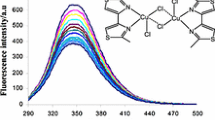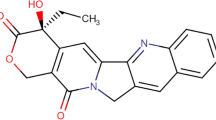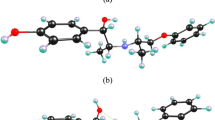Abstract
Metals have been studied as potential chemotherapeutic agents for cancer therapies due to their high reactivity toward a wide variety of substances. The characterization of metal ion-binding capacities is essential to understand the possible effects of metals on target biomolecules. In the present study, biochemical effects of Au(III) and Ga(III) ions on calf thymus DNA (ctDNA) were studied comparatively via bioanalytical, spectroscopic, and thermal methods. Briefly, UV-Vis absorbance spectroscopy, fluorescence spectroscopy, circular dichroism (CD) spectroscopy, and Fourier transform infrared (FT-IR) spectroscopy were utilized for spectroscopic characterization, and isothermal titration calorimetry (ITC) measurements were performed for thermal analysis. Our results reveal that both Au(III) and Ga(III) ions are capable of interacting with ctDNA, and Au(III) ions display a more favorable interaction and a higher binding affinity. ITC analyses indicate that the Au(III)-DNA interaction displays a binding affinity (Ka) around 1.43 × 106 M−1, while a Ka around 1.17 × 105 M−1 was observed for the Ga(III)-DNA binding. It was suggested that both metal ions are unlikely to change the structural B-conformation while interacting with ctDNA.




Similar content being viewed by others
Abbreviations
- ctDNA:
-
Calf thymus DNA
- CD:
-
Circular dichroism
- FT-IR:
-
Fourier transform infrared
- UV-Vis:
-
Ultraviolet-visible
- EB:
-
Ethidium bromide
References
Gómez-Ruiz S, Gallego B, Kaluderović MR, Kommera H, Hey-Hawkins E, Paschke R, Kaluderović GN (2009) Novel gallium(III) complexes containing phthaloyl derivatives of neutral aminoacids with apoptotic activity in cancer cells. J Organomet Chem 694:2191–2197
Samari F, Hemmateenejad B, Shamsipur M, Rashidi M, Samouei H (2012) Affinity of two novel five-coordinated anticancer Pt(II) complexes to human and bovine serum albumins: a spectroscopic approach. Inorg Chem 51:3454–3564
Kaluderović MR, Gómez-Ruiz S, Gallego B, Hey-Hawkins E, Paschke R, Kaluderović GN (2010) Anticancer activity of dinuclear gallium(III) carboxylate complexes. Eur J Med Chem 45:519–525
Tabassum S, Asim A, Arjmand F, Afzal M, Bagchi V (2012) Synthesis and characterization of copper(II) and zinc(II)-based potential chemotherapeutic compounds: their biological evaluation viz. DNA binding profile, cleavage and antimicrobial activity. Eur J Med Chem 58:308–316
Ortega R, Suda A, Devès G (2003) Nuclear microprobe imaging of gallium nitrate in cancer cells. Nucl Instrum Methods Phys Res Sect B 210:364–367
Enyedy ÉA, Dömötör O, Varga E, Kiss T, Trondl R, Hartinger CG, Keppler BK (2012) Comparative solution equilibrium studies of anticancer gallium(III) complexes of 8-hydroxyquinoline and hydroxy(thio)pyrone ligands. J Inorg Biochem 117:189–197
Lessa JA, Parrilha GL, Beraldo H (2012) Gallium complexes as new promising metallodrug candidates. Inorg Chim Acta 393:53–63
Despaigne AAR, Parrilha GL, Izidoro JB, da Costa PR, dos Santos RG, Piro OE, Castellano EE, Rocha WR, Beraldo H (2012) 2-Acetylpyridine- and 2-benzoylpyridine-derived hydrazones and their gallium(III) complexes are highly cytotoxic to glioma cells. Eur J Med Chem 50:163–172
Gabbiani C, Casini A, Messori L (2007) Gold (III) compounds as anticancer drugs. Gold Bull 40:73–88
Aldinucci D, Ronconi L, Fregona D (2009) Groundbreaking gold(III) anticancer agents. Drug Discov Today 14:1075–1076
Casini A, Hartinger C, Gabbiani C, Mini E, Dyson PJ, Keppler BK, Messori L (2008) Gold(III) compounds as anticancer agents: relevance of gold-protein interactions for their mechanism of action. J Inorg Biochem 102:564–575
Maiore L, Cinellu MA, Nobili S, Landini I, Mini E, Gabbiani C, Messori L (2012) Gold(III) complexes with 2-substituted pyridines as experimental anticancer agents: solution behavior, reactions with model proteins, antiproliferative properties. J Inorg Biochem 108:123–127
Arjmand F, Parveen S, Afzal M, Shahid M (2012) Synthesis, characterization, biological studies (DNA binding, cleavage, antibacterial and topoisomerase I) and molecular docking of copper(II) benzimidazole complexes. J Photochem Photobiol B 114:15–26
Wu SS, Yuan WB, Wang HY, Zhang Q, Liu M, Yu KB (2008) Synthesis, crystal structure and interaction with DNA and HSA of (N, N’-dibenzylethane-1,2-diamine) transition metal complexes. J Inorg Biochem 102:2026–2034
Sheng R, Luo T, Zhu Y, Li H, Sun J, Chen S, Sun W, Cao A (2011) The intracellular plasmid DNA localization of cationic reducible cholesterol-disulfide lipids. Biomaterials 32:3507–3519
Chatterjee T, Pal A, Dey S, Chatterjee BK, Chakrabarti P (2012) Interaction of virstatin with human serum albumin: spectroscopic analysis and molecular modeling. PLoS One 7:e37468
Markovitsi D (2009) Interaction of UV radiation with DNA helices. Pure Appl Chem 81:1635–1644
Eshkourfu R, Čobeljić B, Vujčić M, Turel I, Pevec A, Sepčić K, Zec M, Radulović S, Srdić-Radić T, Mitić D, Andjelković K, Sladić D (2011) Synthesis, characterization, cytotoxic activity and DNA binding properties of the novel dinuclear cobalt(III) complex with the condensation product of 2-acetylpyridine and malonic acid dihydrazide. J Inorg Biochem 105:1196–1203
Ju CC, Zhang AG, Yuan CL, Zhao XL, Wang KZ (2011) The interesting DNA-binding properties of three novel dinuclear Ru(II) complexes with varied lengths of flexible bridges. J Inorg Biochem 105:435–443
Ivanov VI, Minchenkova LE, Schyolkina AK, Poletayer AI (1973) Different conformations of double-stranded nucleic acid in solution as revealed by circular dichroism. Biopolymers 12:89–110
Sun J, Lu Y, Wang L, Cheng D, Sun Y, Zeng X (2013) Polym Chem 4:4045–4051
Jangir DK, Charak S, Mehrotra R, Kundu S (2011) FTIR and circular dichroism spectroscopic study of interaction of 5-fluorouracil with DNA. J Photochem Photobiol B 105:143–148
Uma V, Elango M, Nair BU (2007) Copper(II) terpyridine complexes: effect of substituent on DNA binding and nuclease activity. Eur J Inorg Chem 22:3484–3490
McNaught AD, Wilkinson A (1997) Compendium of chemical terminology. Blackwell, Oxford
Sikora C, Turner R (2005) Investigation of ligand binding to the multidrug resistance protein EmrE by isothermal titration calorimetry. Biophys J 88:475–482
Keller PB, Hartman KA (1986) The effect of ionic environment and mercury(II) binding on the alternative structures of DNA. An infrared spectroscopic study. Spectrochim Acta A 42:299–306
Tyagi G, Charak S, Mehrotra R (2012) Binding of an indole alkaloid, vinblastine to double stranded DNA: a spectroscopic insight in to nature and strength of interaction. J Photochem Photobiol B 108:48–52
Nafisi S, Sobhanmanesh A, Esm-Hosseini M, Alimoghaddam K, Tajmir-Riahi HA (2005) Interaction of antitumor drug Sn(CH3)2Cl2 with DNA and RNA. J Mol Struct 750:22–27
Ozdemir A, Tekiner-Gursacli R, Tekinay T (2014) Non-intercalative, deoxyribose binding of boric acid to calf thymus DNA. Biol Trace Elem Res 158:268–274
Acknowledgments
This work was supported by grants from Scientific and Technological Research Council of Turkey (TUBITAK), European Cooperation in Science and Technology (COST) action-112S047. The authors thank Rengin Erdem for her great contributions in UV-Vis absorbance spectroscopy and fluorescence spectroscopy sessions and Alper Devrim Ozkan for his fruitful discussions.
Author information
Authors and Affiliations
Corresponding author
Rights and permissions
About this article
Cite this article
Sarioglu, O.F., Tekiner-Gursacli, R., Ozdemir, A. et al. Comparison of Au(III) and Ga(III) Ions’ Binding to Calf Thymus DNA: Spectroscopic Characterization and Thermal Analysis. Biol Trace Elem Res 160, 445–452 (2014). https://doi.org/10.1007/s12011-014-0059-8
Received:
Accepted:
Published:
Issue Date:
DOI: https://doi.org/10.1007/s12011-014-0059-8




